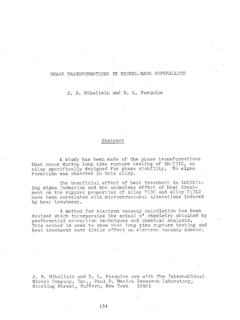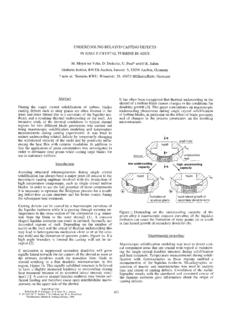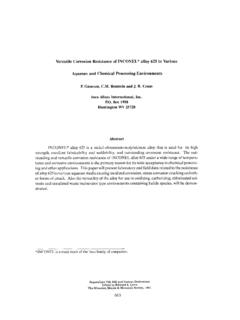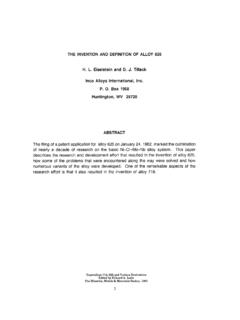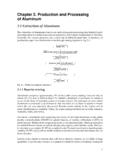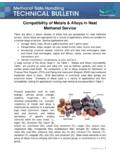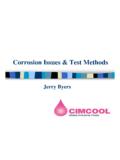Transcription of The Magnesium Problem in Superalloys - tms.org
1 THE Magnesium Problem IN Superalloys A. Mitchell, M. Hilbom, E. Samuelsson and A. Kanagawa Dept. of Metals and Materials Engineering The University of British Columbia Vancouver, , Canada, V6T lW5 INTRODUCTION Magnesium in Superalloys Magnesium is added to nickel-based Superalloys to improve high temperature ductility. This property is important both from the manufacturing point of view, particularly in terms of open-die forgeability, and also from the in-service standpoint where rupture ductility is of primary importance. Further, it has been suggested that Magnesium improves the low cycle fatigue strength 192 . Vacuum Induction Melting A typical VIM cycle starts with the charging of either virgin raw materials or scrap. Following the pumping down, the furnace contents are melted. When the metal is entirely molten and the bath stable, desulphurizing or deoxidizing additions are made.
2 Finally, reactive elements are added, and when the bath composition is correct the melt is 3 cast . Additions of aluminum and alkaline earth (AE) or rare earth (RE) metals decrease the activity and content of oxygen during the melting of a virgin heat. The increase of oxygen in the revert heat is probably due to pick-up from the refractories. In both cases, however the AE or RE additions help with the removal of oxygen-containing inclusions by the suggested mechanism of globurizing the alumina clusters 4 . Superalloys 1988 Edited by S. Reichman, Duhl, G. Maurer, S. Antolovich and C. Lund The Metallurgical Society, 1988 407 Calcium, Magnesium , and rare earth metals are also strong desulphurizing agents. Figure 1 shows that the sulphur content can readily be reduced from - 150 ppm to - 10 ppm. The sulphide products deposit on the crucible walls.
3 Hence, it is critical that the correct amount of desulphurizing agent can be predicted for each charge4. + on molt- down 0 at malt end 200- Fi *-*- c 5 IOO- / /- *---f J 0 - 12345678 HEAT No. Figure 1: Reduction in melt sulphu induction melting period r content [S] over vacuum . Alexander4 suggests that the removal of Magnesium from VIM melts is controlled by liquid mass transfer while Fu et al 5 suggest that the controlling steps are liquid mass transfer and the evaporation reaction. However, the latter were forced, for lack of better data to assume that the activity of Magnesium in nickel alloys is equal to the content. Clearly, additional data is required for more accurate analysis of the evaporation process during Vacuum Induction Melting. Vacuum Arc Remelting Fu et al5 investigated the evaporation of magnesiuim from a nickel-base superalloy during VAR.
4 They found that Magnesium evaporates mainly from the electrode tip. It was suggested that the evaporation rate is limited by the transport of Magnesium through the melt to the surface. However, the analysis of the Problem is limited by lack of fundamental data. Electra Slag Remelting Ichihashi et al6 investigated the ability of the ESR process to retain titanium, aluminum, and Magnesium in the metal using different slag compositions. They show that increasing the contents of CaO and MgO will increase the content of Magnesium in the ingot, as seen in Figure 2. They 408 also suggest that titanium or aluminum can be lost to the slag through following reactions: 3 MgO + 2E + A1203 + 3 Mg 2 MgO + Ti 2 TiO - 2+2Mg 0: CaO>2Sm0 0: 15rCa052 a: 5~CaOrls r-----l .: caos5 150 .(CaF,-MgO) MgO (molX) Figure 2: Effect of MgO content b 'n the ESR slag on Mg content in produced ESR ingots.
5 Simultaneously, these reactions would increase the Magnesium content in the alloy. It may be noted that proper control of the reactive element content is dependent on a delicate balance between slag and metal chemistry. Ichihasi6 also found that Magnesium can not be retained in the metal unless the slag is protected from air oxidation by an inert atmosphere, such as Generally, the conclusions of Chen et al. 7 argon. agree with those of Ichihashi'. Electron Beam Melting The Electron Beam melting process has recently emerged as another alternative for superalloy refiningg. The process, usually applied in the form of a Cold-Hearth Refining (EBCHR) furnace, offers more flexibility as to melting speed and ingot shape than the VAR process, since the heat source is independent of the charge material. However, the large area to volume ratio in the EBCHR process makes evaporation of alloying elements unavoid- able.
6 Hence, knowledge of the evaporation parameters of alloying elements is important if desired alloy compositions are to be produced. Mitchell' and Herbertsonl' have discussed the evaporation of Magnesium from Superalloys during EBCHR refining. Mitchell' suggests that the 409 evaporation rate is controlled by the evaporation step and gives an evaporation rate constant of x 10 -7 -1 m s at 1700 C. On the other hand, Herbertson 10 claims that the evaporation rate is controlled by bulk mass transfer and gives a Langmuir evaporation rate constant of x 10 -1 -1 m s at 1700 C. It appears that Herbertson 10 has arrived at this value assuming an activity coefficient for Magnesium in the liquid superalloy of unity. Using the suggested activity coefficient by Mitchell' of 10 -3 for Magnesium in liquid nickel, one arrives at an evaporation rate constant of x 10 -4 m -1 S at 1700 C and x 10e4m s -1 at 17OO"Cll.
7 This would mean that Magnesium evaporation is controlled by a combination of liquid mass transfer and evaporation. Hence, the activity coefficient is important in determining the rate-controlling step for evaporation during EBCHR refining. Magnesium and Calcium in Nickel and Iron alloys The thermodynamic data of dilute iron solutions are better known than those for nickel solutions 12,13 . Therefore, when data for nickel alloys are lacking, many investigators apply those for iron as a best approximation. While this may be a valid approach for many systems, in the case of Magnesium and calcium it is probably far from correct. While the Mg-Fe phase diagram is incomplete, the binary systems Mg-Fe and Mg-Ni are essentially opposites 14,15 . Nickel- Magnesium exhibits complete solubility in the liquid phase and two intermetallic compounds in the solid phase, whereas iron-calcium has an extensive miscibility gap in the liquid phase and no solid intermetallic phases.
8 The situation is similar for the calcium-nickel and calcium-iron systems. The Ca-Fe phase diagram is even more tentative than the Mg-Fe diagram 16 , but it is well known that the solubility of calcium in liquid iron is only weight 17 percent . As in the nickel- Magnesium system, nickel-calcium exhibits several solid intermetalllc compounds and complete solubility in the 18 liquid . In terms of activity data one can then expect y Ca'YMg > 1 in iron as in these systems the like atom attractions are stronger than the unlike atom attractions. In contrast, in nickel solutions yCa/yMg ought to be smaller than 1 as the intermetallic compounds indicate unlike atom attraction. This is also confirmed by Meysson and Rist 19 for nickel and iron-rich solutions containing calcium. 410 de Barbadillo 20 also discusses the influence of other alloying elements on the solubility of Magnesium in nickel alloys .
9 For instance, iron and chromium decreases the Magnesium solubility. While insufficient data are available de Barbadillo manages to propose a tentative ternary liquid phase diagram for the Fe-Ni-Mg system. Figure 3 reproduces estimated activity data based on the limited data for the binary Ni-Mg the system Ni-Fe-Mg 22 . MQ Figure 3: d activity of Magnesium in . system 21 and data for the Fe-Ni-Mg Magnesium and Calcium No experimental study of the deoxidation equilibria of Mg and Ca in nickel-base alloys has been found in the literature. Some work has been done on these elements in various iron-based solutions 23-26 . While these data may be useful in establishing deoxidation equilibria in nickel-base alloys the different solubility of Mg/Ca in the two solvents cannot be forgotten and must be taken into account in using the data of Tables I & II.
10 TABLE I: Deoxidation Equilibria in Iron alloys Deoxidation Reaction log K I K x 1013 x 1013 x 1o13 Ca + 0 = CaO x lo5 x lo6 Mg + 0 * MgO x lo5 r ( Cl Ref. 1600 28 1600 27 1600 23 1600 23 1600 24,25 1600 24,25 i i 7 411 TABLE II: Deoxidation Equilibria in Nice1 alloys EXPERIMENTAL The technique used to determine the activity coefficient of Mg in nickel-base alloys was the novel one of measuring vapour pressure with an atomic-absorption spectrophotometer. The experimental details are given in reference 29. The system was calibrated using both pure Magnesium and Mg + Sn alloys . The equilibrium constant for the reaction: @(is) = h]Ni was determined as: log K = at 145 OOC The Raoultian activity coefficient of Mg at 145O'C was found to be ( ) x 10 -2 , with e Mg 0 = -28 . The addition of Al, Fe and Cr did not substantially change these values in the concentration ranges up to 50% Ni, as shown in Figure 4.)
